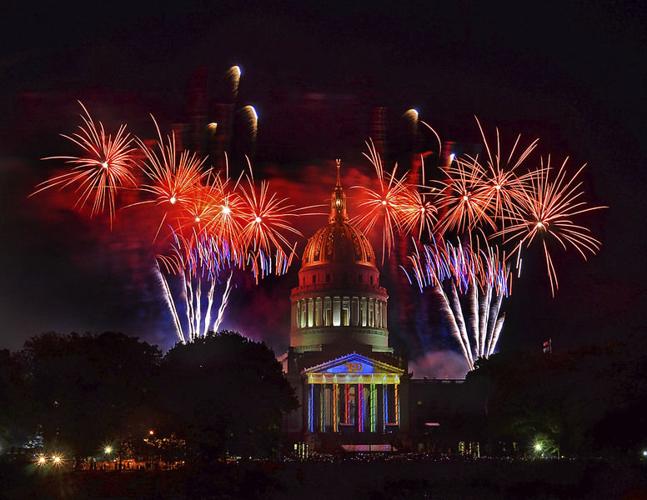West Virginia became the 35th state June 20, 1863, when it split from Virginia – 156 years ago. ¶ Unofficial celebrations were held across the state for the next 64 years to mark the occasion. ¶ In 1927, the West Virginia Legislature made June 20 an official state holiday. ¶ The state’s first governor was Arthur I. Boreman, of Wood County, who was elected May 28, 1863 and took office June 20. ¶ Created during the Civil War (1861-1865), Boreman termed the new state “the child of the rebellion.”
Naturally divided by the Allegheny Mountains, there were many differences between the people of western Virginia and those in eastern Virginia. The eastern portion boasted large plantations on gentle-sloping terrain that produced cash crops such as tobacco. The western portion of the state is mountainous and the terrain much more rugged.
Including slaves in the population count, the eastern portion also had more representation in the state government, according to historians.
People in the western part of the state also believed they were slighted in terms of roads, railroads, and other improvements.
In the years leading up to the Civil War, slavery became an increasing source of contention between the two areas of Virginia.
When Virginia seceded from the Union in 1861 on a convention vote of 88 to 55, those in the western part of the state opposed the decision and worked to create their own government, basically seceding from Virginia.
“West Virginia should long since have had a separate state existence,” Boreman said in his inaugural address on June 20, 1863. “The East has always looked upon that portion of the state west of the mountains, as a sort of outside appendage – a territory in a state of pupilage...”
Despite concerns about the constitutionality of West Virginia’s statehood, President Abraham Lincoln signed the statehood bill Dec. 31, 1862.
“Doubtless those in remaining Virginia would return to the Union, so to speak, less reluctantly without the division of the old state than with it; but I think we could not save as much in this quarter by rejecting the new state, as we should lose by it in West Virginia,” Lincoln wrote in his opinion.
“We can scarcely dispense with the aid of West Virginia in this struggle; much less can we afford to have her against us, in Congress and in the field.
“Her brave and good men regard her admission into the Union as a matter of life and death. They have been true to the Union under very severe trials.
“We have so acted as to justify their hopes; and we can not fully retain their confidence, and co-operation, if we seem to break faith with them,” Lincoln wrote.
Initially, the plan was to name the new state Kanawha, with 39 counties.
Later in 1861, officials changed the name to West Virginia and added five more counties in December, then four more counties were added in 1862.
The new state preserved the established borders with Kentucky, Ohio, Pennsylvania and Maryland while creating a new border with Virginia based on existing county lines.
“While sectional differences and mountain barriers were often cited to justify the dismemberment, in fact the new border cut diagonally across geographical features in many places and followed the dividing ridge between eastern and western rivers for only 75 miles out of 400,” according to the West Virginia Encyclopedia.
Also during his inaugural address, Boreman asked the state legislature to decide on a permanent state Capitol location. When the legislature refused, lawmakers authorized Boreman to acquire the Linsly Institute building in Wheeling, where the new state’s first gathering was conducted, to serve as a temporary Capitol. Wheeling was also the state’s largest city at the time.
In 1869, the government seat was moved to Charleston, which was more centrally located. However, critics said Charleston lacked the necessary transportation, hotels and restaurants for the state’s government seat.
As a result, the Capitol was moved back to Wheeling in 1875.
With the controversy over the Capitol location continuing, the issue was put before voters on Aug. 7, 1877 with a choice of three locations; Wheeling was not among the choices. Charleston received the most votes, followed by Clarksburg and than Martinsburg.
The first state Capitol was built in Charleston in 1885, then consumed by fire in 1921. The next Capitol building was built, then again was destroyed by fire in 1927.
A Capitol Building Commission was created by the state Legislature in 1921 and authorized construction of the current Capitol. Architect Cass Gilbert designed the structure, in the Italian Renaissance style, at a cost of nearly $10 million.
“The exterior of the classical-styled building is buff Indiana limestone,” according to the West Virginia Division of Culture and History. “More than 700 train carloads of limestone and 4,640 tons of steel were used in its construction.
“The magnificent 293-foot gold dome which tops the structure is five feet higher than the dome of the U.S. Capitol. The entire dome is gilded in 23 and a half karat gold leaf applied to the copper and lead roof in tiny 3 and three-eighths inch squares.
“Two thirds of the interior of the Capitol is marble – White Imperial Danby Vermont, Italian Travertine, and Tennessee.
“Consisting of 535,000 square feet of floor space, the building has 333 rooms in its main unit and two wings.”
Gov. William G. Conley dedicated the completed state Capitol on June 20, 1932 – the state’s 69th birthday.


























Commented
Sorry, there are no recent results for popular commented articles.